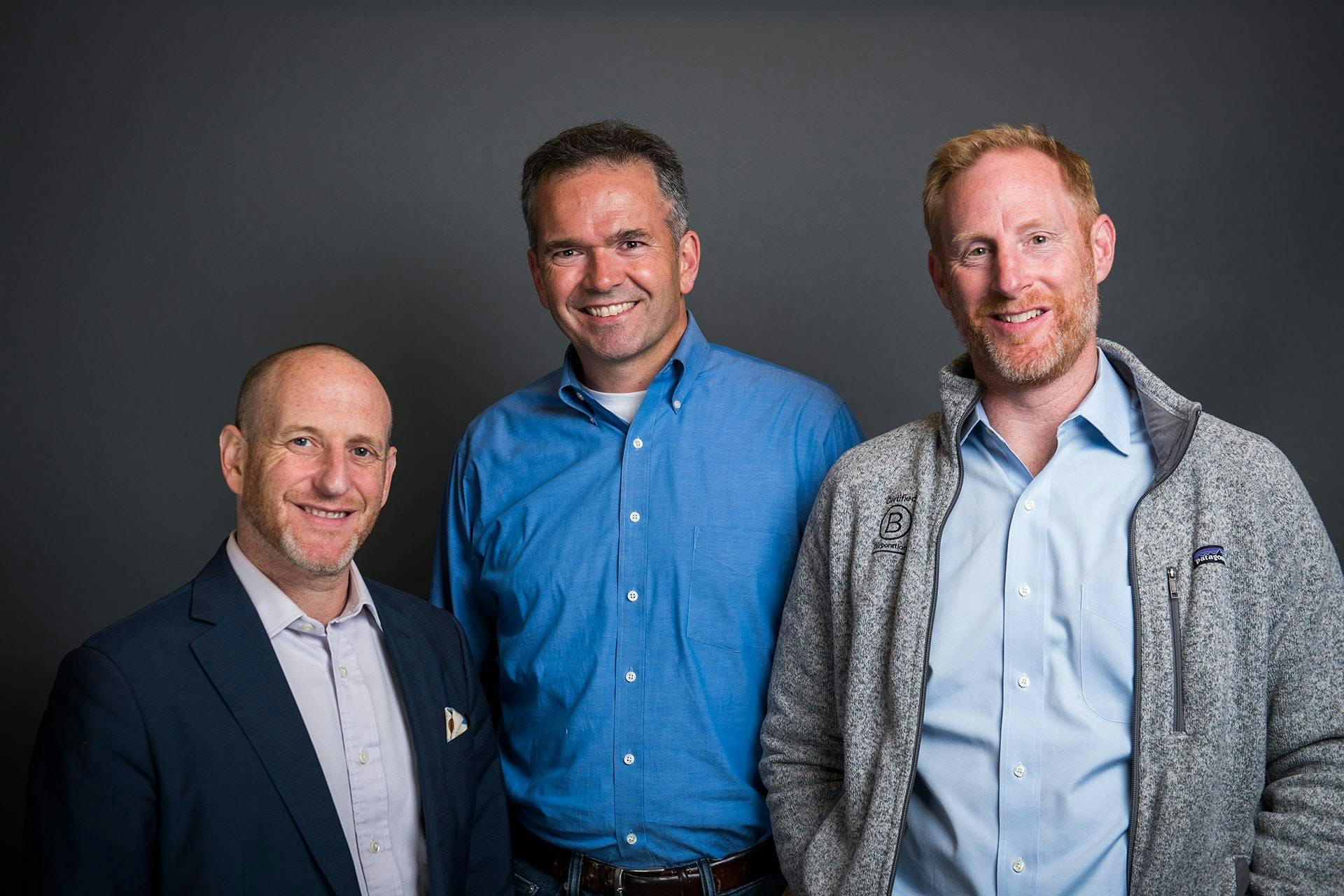How to become a responsible business leader: An interview with B Lab CEO Jay Coen Gilbert
Lab’s Jay Coen Gilbert tells Startup Guide how entrepreneurs and business leaders how their companies can drive positive impact and change by joining B Lab’s global network, and even becoming a B Corp.
Whether you’re new to the world of entrepreneurship or have been a leader within your ecosystem for some time, it’s no longer possible to ignore the urgency surrounding the state of our planet’s future. Now that the climate crisis and social inequality are a huge part of the public discourse, there needs to be a cultural shift in how businesses define and work toward success.
“The global economic system is no longer fit for purpose and in urgent need of redesign,” says Jay Coen Gilbert, the cofounder of B Lab, the organization behind the B Corp Certification with over 3,000 companies certified and all using business as a force for good. “Governments alone are not able to protect and restore our overstressed planet and rebuild our fractured society, so business needs to take its vital role as a force for positive change.”
So how do you as an entrepreneur or founder lead your company and ecosystem toward a brighter future?
One way to shift your company toward purpose, and become a beacon for other companies looking to make meaningful change, is to follow Jay’s example and become a B Corp.
B Corp Certification is given to companies that commit to purpose and promise to value people, planet and profit in a way that shows they are contributing to a better, more sustainable world. To receive the certification, companies must pass the B Impact Assessment (BIA), which is very comprehensive and rigorous.
Companies that have successfully attained the mantle of B Corp include Ben & Jerry’s, several Danone entities, Lombard Odier, TOMS, Patagonia, Tony’s Chocolonely and Innocent Drinks, to name just a few of the companies that are changing business paradigms toward equality and sustainability.
To learn more about becoming a B Corp, the benefits of the movement for all stakeholders and how the initiative got started, Startup Guide CEO Sissel Hansen and I caught up with Jay during the fourth annual B Corp summit in Amsterdam.
Read on to discover what it means to be a B Corp, the steps to take toward that certification and the importance of aligning your business with a higher social, economic and environmental purpose.

Startup Guide: What inspired you initially to create the B Corp movement?
Jay Coen Gilbert: What initially inspired me was a bottle of salad dressing from a company called Newman's Own. What they were known for was donating 100 percent of their profits to charity, and this beautiful little logo on the top of the salad dressing, which was a heart with a dollar sign through it. That inspired me because as a business person at the time, when I thought about social impact, I mostly just thought about charity, which I think is what most people think about. I started to think about what it would be like if there were thousands of companies around the world using their business as a powerful tool to generate charitable wealth.
As I talked to entrepreneurs and investors and other thought leaders, they helped me see that the highest impact thing that a company could do was not give whatever profits they had away. How they generated those profits was actually a far more powerful part of the business. And so it was through that learning that the idea of a B Corp shifted from just being about companies that gave all of their profits to charity to companies that were using their entire business model as a force for good: from how they treat their employees or who they employ, or where they source from, and what their relationship with their suppliers are, to how they engage with their communities or what their environmental footprint is.
And then the even deeper cut was, of course, understanding that you wanted that to take place over time. You want the good that you create to endure. That's your legacy as an entrepreneur. That's when the deeper insight around what underlying governance structure and legal structure of the company can support or hinder that kind of positive impact activity came into play. This can make it more likely that positive impact activity sustains throughout the life cycle of the business.
You want the good that you create to endure. That's your legacy as an entrepreneur.
SG: On a more practical level, what does it mean to be a B Corp? What do you wish more companies knew, especially those that want to come to you hoping to drive positive change?
JCG: What it means to be a B Corp is that you've met the most rigorous standards for overall social and environmental performance, and that those things have been verified by an independent third party. That's what B Lab does. Anybody can use those standards for free, whether you want to be a B Corp or not. There are 80,000 companies around the world that are using them. Any startup around the world can say: “Here's a roadmap, or a toolkit, for the questions I should ask myself if I want to be a purpose-driven, high impact entrepreneur.” Now, if they want to get certified and be recognized for their leadership, then they would need to get their performance verified by our standards team. So they would complete the BIA, and if they received a minimum verified score of 80, they would then receive the certification and have to be transparent on bcorporation.net. Then they would also have to actually change the legal DNA of their company so that they are accountable for considering the impact of the decisions on all stakeholders, not just shareholders, and that's really the seed of the system change that we've been talking about. B Corps are becoming living, breathing manifestations of that system change. And then by proving that it's possible, and that you can raise plenty of money with that governance structure, and be both profitable and purposeful at the same time, they become the proof of concept that enables that system change to happen on a much broader level.

Sissel Hansen: Have you experienced people coming to you and saying they want to set up as a B Corp before even setting up their company? What do you say to them?
JCG: We have something called the pending B Corp. It's like in the US when you apply for a patent, before the government gives you the patent, it’s patent pending. And so similarly, it's like certification pending. The idea is that in order to become a pending B Corp, which is really created for startups, we say the first thing you're going to have to do is incorporate your entity. So as long as you're going to do that, you might as well do it in our legal structure, building it on the right foundation. We give people the tools for free. We’ll give you the actual language that you can use to incorporate into your LLC agreement or into your corporate documents that says, “We're going to be a company that is accountable to society, not just to our shareholders; we're going to consider the impact of our decisions on everybody, not just on ourselves.” And once you do that, that's like laying the right foundation for a purpose-driven business that's built to last. If you do that, you can be a pending B Corp. And then by the time you’ve finished your first year of operations, when you actually have a business, then you go through the impact assessment, and if you get a verified score and pass, then you can turn the pending certification into a full certification. When you’re a pending B Corp, you signal to your first customers, employees and investors that you’re going to be a purpose-driven business that's going to use profit as a fuel, not as the destination.
SG: What advice would you give both to pending B Corps and companies that are thinking of becoming B Corps?
JCG: Build your house on a strong foundation. Your legal structure is the foundation of your corporation. And so before you do anything else, make sure that your legal structure is set up so that you can retain the mission control of your business. You might end up having to raise money and eventually give up financial control. That's not necessarily a bad thing. What's been bad is, historically, financial control has been inextricably linked to mission control. But with the B Corp structure, we can decouple financial control from mission control, so you as the entrepreneur who has a passion for using your business for this social purpose or this environmental purpose can hang on to that mission.
It used to be that whoever owned the stock owned the mission. If you need to raise money, you're probably going to have to give up some of your stock, and you're going to have to give up some of your equity. With the B Corp structure, you no longer have to fear that when you give up that equity, you lose control of the mission of your business. People underestimate the importance of the unsexy part of the incorporation process that actually sets the trajectory of your business. It will be more and more important, especially as you start to raise outside capital and bring in new partners and employees, that you are aligning your incentives and values around purpose.

SG: How do you keep people inspired? Some of the leaders speaking at the summit have said that the journey ahead will be hard and there will be disappointment, so with that in mind, how do you keep people believing that system change and positive impact are possible?
JCG: One of the mantras we have at B Lab is to remember that this is a marathon not a sprint. This is very difficult work. And it's never-ending, which can easily deplete your energy. One of the things that we try to do at the lab and with our community is to make sure that we do a good job taking celebratory pauses. We acknowledge the wins when they happen and take a moment to share them, whether it's on Slack or during our gatherings. Because what really gives us strength is what the individual entrepreneurs are doing in their work every day. That gives us new energy. It's too easy to get stuck in the magnitude of the problems and not celebrate the individual wins. For all of us trying to run the marathon, it’s about taking it one day at a time. And there are probably times during each of those days where you need to create some pauses just to breathe or connect with a company or a person that's really inspiring so that you can then return to the unsexy hard work that all of this actually is.
SG: Part of the summit was introducing the creation of the SDG Action Manager, which you’ve built with the UN Global Compact to help companies measure and manage business action geared toward the 17 Sustainable Development Goals (SDGs). What prompted this tool? How has this idea evolved, and what can we expect from the Action Manager?
JCG: What inspired the SDG Action Manager was the opportunity to use the SDGs as a globally recognized framework for identifying the world that we want. 193 countries around the world agreed that these are the goals for the next decade. And we're not going to be able to achieve those goals without meaningful contributions from business. B Lab already has the most widely used impact management platform in the world, with over 70,000 businesses using the BIA as their roadmap and toolkit for how to use their businesses as a force for good. We want to map the BIA to the SDGs, so no matter where you are in the world, you can use the free tool of the BIA to identify the business actions that you can take to contribute to the SDGs and communicate those actions to the world, which might tempt a lot more businesses to be a force for good by using the SDGs as their framework.

Sissel: So let’s say I’m already using the lean canvas or another model to determine my value proposition; how does the SDG Action Manager fit into that?
JCG: So let’s say you take climate action, and you want to get involved in that. You understand the climate emergency and you want to figure out how your business can be taking action against it. You would go to the BIA and to the SDG Action Manager, click on the number for climate action, and get a set of twenty or thirty questions to help you know what’s most important to answer for your business in contributing to climate action.
Within each of those questions, you're going to have tools, resources and case studies that help you understand what those actions are, whether it's around a life-cycle assessment, calculating greenhouse gas emissions, negotiating with your landlord, your energy solutions, or whatever it might be; you're going to have all of those tools. And then you're going to be able to benchmark your performance against thousands of other businesses around the world. Since we’re all business people (we’re all pretty type A competitive people by nature), knowing how we benchmark against others can be motivating, not just for you as the leader but for all the people within your organization.
Sissel: And it also gives you way more data to learn from. When I talk with impact entrepreneurs, one of the things they keep coming back to is the question of how to measure impact.
JCG: The BIA is the most widely used impact measurement and management tool, and it can axiomatically be applied to the SDGs. The thing I think is really cool about it is that when you pick an SDG, SDG 1 for example, because your business is working in the Global South around poverty alleviation in sub-Saharan Africa, you’re going to know that there are thousands of other companies around the world that have also selected SDG 1 as their central purpose.
And so you're going to be able to join a global community of practice all trying to address that issue. That's a really powerful thing, not only for individual learning but for collective learning through the community of practice. I think that's really the power of the B Corp community. A tool like the SDG Action Managers helps facilitate that kind of communal growth.

Photo: Jay with his co-founders, Andrew Kassoy (left) and Bart Houlahan (center), the Certified B Corporation
Sissel: I was at the World Economic Forum last year and I was shocked by how people with extreme amounts of money have no idea where to put their wealth. One of the things that I would like to do in the future – why we gather as much data as possible – is link family offices, philanthropists, foundations, and more to companies that are already doing good. What are possible solutions to this?
JCG: We’ve worked a lot with the investment community – early stage investors, funds, family offices, community foundations – who are seeking the same thing, which is: “How do I find a pipeline of investable businesses where I can be clear that there's a return opportunity, but there is also clearly measured social and environmental impact?” Lots of organizations already exist that are trying to connect those family offices, community foundations and early stage investors with startup businesses and early stage high-growth businesses. I think that's going to be a big opportunity.
Remember, when you talk to a philanthropist, you're only talking about one of their pockets. You're talking about their philanthropy pocket, which is usually the smaller pocket compared to their investment pocket. And so what you want to talk to them about is impact. And some of those things may be best as donations, right? But there's a lot more money sitting in the investing pocket. The question is, how can we help those high-net-worth individuals or wealthy families think about activating their total portfolio, not just their philanthropic portfolio, and asking, what is the purpose of your capital? The purpose of your capital is to create a positive impact in the world.
One of the ways to invest in purpose is to invest in B Corps with verified performance, with institutionalized stakeholder governance. Just make sure the companies have purpose sitting at the center of their business, and not to invest just because you believe in the CEO you’re talking to today. You want the purpose to last longer than any individual, just like when wealth is created over generations of a family. You want to make sure that the generations of leadership for that business are all accountable to that same higher purpose.
Header photo by Adrien Olichon
To learn more about becoming a B Corp, hop onto their website, and also enjoy inspiring stories from companies that have gone through the process to become responsible business leaders. Startup Guide works to highlight the very best in impact entrepreneurship, and to further that goal we’ve published Startup Guide Switzerland, our first impact-focused book. We’re also coming out with a regional impact book about some of the exciting hubs in Africa, so stay tuned for that!

